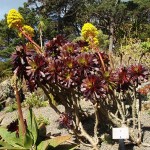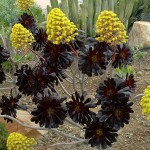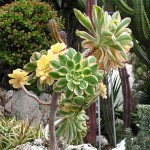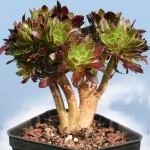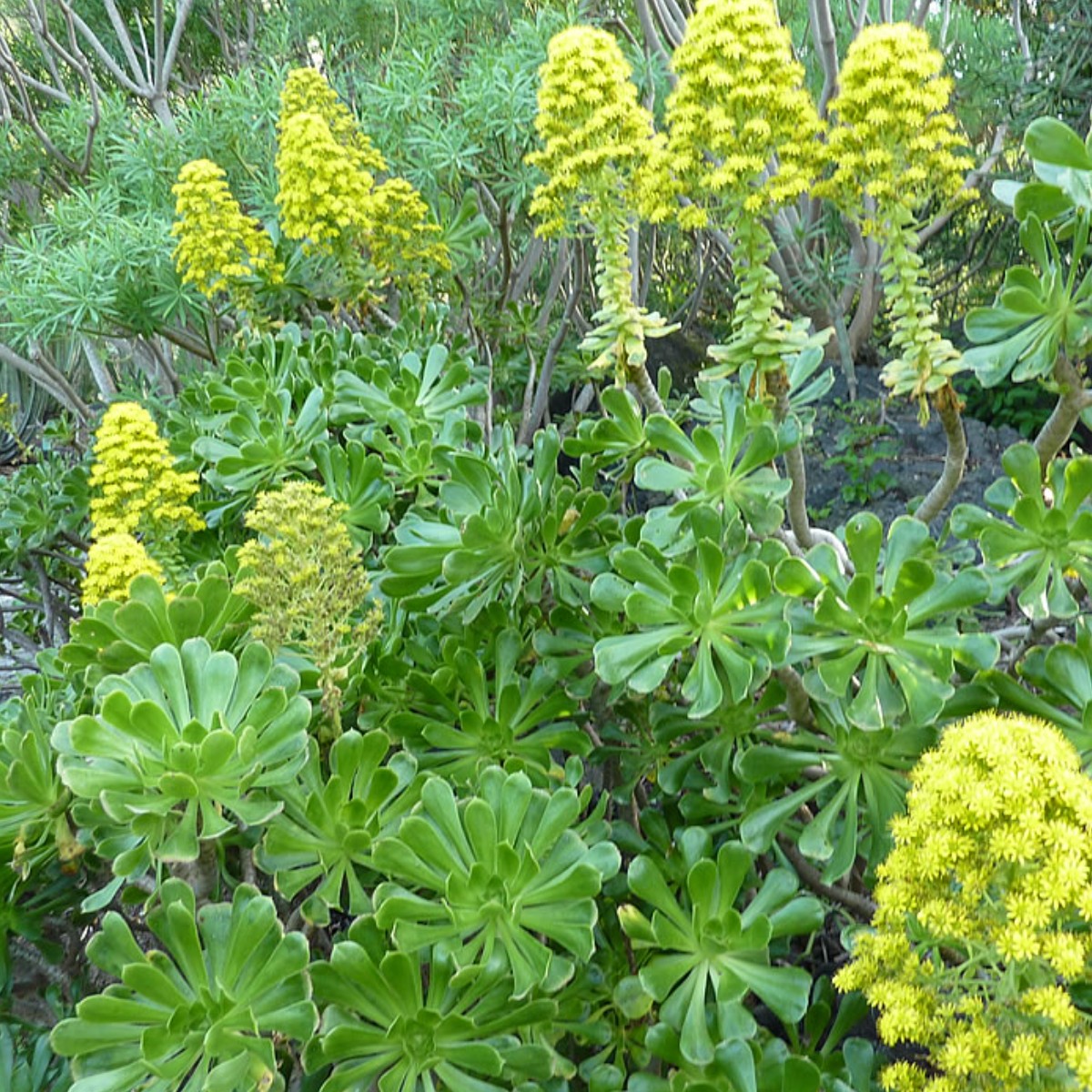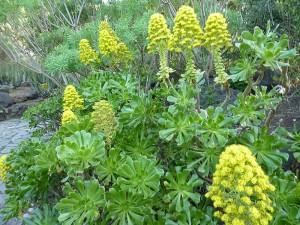Family: Crassulaceae
Synonymous: Sempervivum arboreum
Aeonium manriqueorum
Distribution and habitat: Aeonium arboreum is a subtropical succulent sub-shrub native to the hillsides of the Canary Islands where their natural range includes arid desert regions.
It bears rosettes of leaves and large pyramidal panicles of bright yellow flowers in the spring. Each rosette that bloom will die.
Description: Aeonium arboreum is a treelike in that its woody stems branch out freely, but it is unlikely to exceed 90cm (3 feet) in height. The 5-8cm (2-3 inch) long leaves of its rosettes are spoon-shaped and shiny green. The leaf rosettes are arranged at the ends of its branches.
These plants grow quickly and produce abundant small, star-like, bisexual, yellow flowers on racemes from late winter through early spring. Flowers stems emerge from the center of the rosettes. The rosette die after flowering. If the plant has produced side shoots, they will live on. If not, the entire plant will die off. New plants can be started from the seed.
Proper care: In regions where winters are cool, Aeonium arboreum plants appreciate summer sun outdoors and then can grow indoors as houseplants when weather cools.
Aeonium arboreum plants are quick growers. Leggy branches do tend to fall over and snap off from the weight of the rosettes. If this happens, the broken stem can be used for propagation.
The plants tend to go dormant in the summer and look a little tired sometimes, but they perk up again in the fall. Care should be taken with these plants to avoid overwatering.
Light: To keep their form, Aeonium arboreum need full sunlight, even during rest periods when they are not actively growing. Too lithe light will result in elongate, prematurely falling leaves and gap rosettes.
Temperature: Aeonium arboreum grow well in warm rooms about 18 to 24C (64-75F), but like most other succulents - they are not tropical plants. If possible they should be encouraged to rest during the winter months by being moved to a cool place - preferable around 10C (50F).
Watering: During the active growth period water Aeonium arboreum moderately - enough to make the potting mixture moist throughout, but allowing the top 1cm (0.4 inch) of the potting mixture to dry out between waterings.
During the rest period, allow half of the potting mixture to dry out between waterings. Less than this will result in shriveled leaves. On the other hand, over-watering will encourage soft, untypical leaf growth, which is likely to droop.
Feeding: Use liquid fertiliser about every two weeks during the active growth period only.
Potting and repotting: Use a porous potting mixture composed of one part coarse sand or a substance such as perlite added to two parts of a standard soil based mixture. Because Aeonium arboreum can grow quickly, the taller kinds should be moved into pots one size larger every year, preferably just as new growth begins. Newly potted plants should be especially firmly pressed into the potting mixture and taller Aeonium arboreum must be staked.
Gardening: The Aeonium arboreum thrives in temperatures that range from 4 to 38C (40-100F). During the winter, it will grow best with nighttime temperatures of 10C (50F). These succulents can be interesting and fun plants to grow, thriving outdoors in areas with dry summers and warm winters. The ideal climates are Mediterranean- relatively dry with seasonal rainfall (preferably in winters, not summers) and no freezes. Growing these plants in the tropics, the hot deserts or where it snows will be very difficult.
These plants are suitable for pots and they can be moved in and out depending on weather situations. Plants in containers require more frequent watering than those in ground.
Position:Aeonium arboreum grows best in full sun during the cooler months and when grown in coastal areas. When grown inland or during the summer, provide these succulents with afternoon or partial shade. Avoid placingAeonium arboreum plants in sites with western sun exposures.
Soil: ThoughAeonium arboreum tolerate a variety of soil types - as long as the soil is well-drained - it prefers light, porous soil. Is recommended to amend the planting site with sand and limestone chips. For container gardening, plantAeonium arboreum in a moderately moist medium with excellent drainage such as a planting mix that includes 2 parts sand, 1 part loam and 1 part peat moss with a handful of small gravel pieces thrown in to enhance drainage.
Although it is recommended to place a thin layer of inorganic mulch, such as ornamental rock, around the plants.
Irrigation: Water Aeonium arboreum plants deeply but infrequently. Allow them to dry thoroughly in-between waterings. In the wild, these succulents go dormant in summer, so water sparingly during the hotter months, allowing the soil to dry out between waterings. Watering during the summer is require only in very dry conditions.
During the winter months restrict water to about once a month or just enough to keep the foliage from shriveling. In extreme heat, their leaves will curl, to prevent excessive water loss.
It growing these succulents along the coast, the humidity and rains or mist will often be enough to satisfy the water needs of these plants. But in dry climates they will probably need to be watered frequently or put on drip irrigation. They do not need to be thoroughly watered, though as the main water-absorbing roots are near the surface with the deeper roots functioning nearly solely as support.
Fertilisation: TheAeonium arboreum does not require much fertilizer. Two to three applications of a balanced fertilizer during the growing season will feed these succulents.
Propagation: Aeonium arboreum are easy to propagate from tip cuttings. The best time to do this is early in the growth period. Cleanly detach a complete rosette together with 2-4cm (0.8-1.5 inch) of stem, dip the stem into hormone rooting powder to encourage rooting and plant it is a moistened mixture of equal parts peat moss and coarse sand or a substance such as perlite.
Cuttings will root in two to there weeks in a warm room - 18 to 24C (64-75F) if given bright light and watered only enough to make the potting mixture barely moist. They can then be repotted in the potting mixture that is used for mature plants.
Propagate by seed sown at 18-24C (64-75F) in spring, but is a slow propagation method.
Problems:Aeonium arboreum plants enter dormancy as summer temperatures climb, dropping their foliage rosettes to direct energy toward their stems or growing tips and roots. Leaf loss from seasonal dormancy is temporary and natural and is not accompanied by other worrying symptoms such as wilting, discoloration or stem dieback. Fall rain revives the plants until colder temperatures set in and prompt a second, less profound dormancy period in winter.
ThoughAeonium arboreum is not particularly susceptible to infestations, insect pests include aphids, mealybugs, scale insects and thrips.
Treatment: Combat these insects with horticultural soaps or neem oil. However, care should be taken when using soap spays as too frequent spraying can cause discoloration and lesions on the skin of the plant.
If an Aeonium arboreum succulent is planted in a site with poor drainage, its roots may rot.
Treatment: Root rot is prevented by using clay pots with good drainage or checking soil percolation prior to planting. Keep the roots moist but never soggy.
Temperatures below minus 7C (20F) will badly damage the leaf tips and may cause foliage loss. Conversely, direct sun exposure and temperatures above 38C (100F) will also cause foliage loss and damage, particularly if the soil is too dry.
Slugs, snails, deer,grasshoppers can do some damage to Aeonium arboreum plants and the occasional bird may take a bite.
Lifespan: Aeonium arboreum is a monocarpic species, meaning that it dies after flowering. It is expected to live about 3 to 10 years as it reach its full maturity. Although their yellow flowers are attractive, each time they bloom, a rosette dies. Flowering can be avoided by clipping off the flowerheads as they begin to emerge. Also, this succulent can be preserved in time by cutting the terminal rosette every year in late winter and propagating it by planting the rosette at the plants base, where it will form roots, creating a new Aeonium arboreum plant.
Recommended varieties:
Aeonium arboreum var. atropurpureum (Dark Purple Houseleek Tree, Black rose, Black Beauty, Black Tree Aeonium) has a slightly smaller deep purple leaves, but the colouring loses intensity if the plant is grown in full sunlight.
Aeonium arboreum cv. Schwarzkopf (Aeonium Blacktop, Black Rose, Black Beauty, Black Tree Aeonium) is a variety with almost black foliage.
Aeonium arboreum var. albovariegatum is a variety with white margined leaves.
Aeonium arboreum var. atropurpureum forma cristata (Crested Black rose, Crested Black Beauty, Crested Black Tree Aeonium) is a crested succulent shrub that produces magnificent, fun shaped purple, leaf rosettes at the ends of its branches and seems to to change in and out of its crested mode during the years.
Companion plants: Consider growing Aeonium arboreum as part of a cactus or succulent display. It can be combined with other plants such as Aloe, Agave, Crassula (jade plants), evergreen Echeverias species or can be combined with other members of its own genus.
Note: Aeonium species are often confused withEcheverias species or other several rosette-like succulents such as Dudleyas, Graptopetalums, Pachyverias and Graptoverias species.
One thing that sets these plants apart is the way their leaves attach to the stem - they are wrapped around the stem with a fibrous attachment so that when a leaf is pulled away, the stem is intact with only a transverse line showing where the leaf was attached. The other rosette Crassulaceas have succulent attachments and their being pulled off the stem leaves a divot in the stem.
Uses and display: Aeonium arboreum make excellent bedding plants, since their architectural shape contrasts well with most other bedding plants. When grown in the garden, Aeonium arboreum command the most attention in masses. Place them along sunny borders or in rockeries or they can be used as part of xeriscaping, being drought tolerant plants. These succulents are often used in architectural city and courtyard gardens in coastal mediterranean sub-tropical climate. In temperate or cooler zones, frost may kill the foliage and the rosette will fall off. If the plant is mulched it will grow a new one in spring.
Aeonium arboreum can also be used effectively planted in containers and grown indoors. Consider growing them as part of a cactus or succulent display.Aeonium arboreum is a tall variety with bonsai like look when they get shrubby. They can be trimmed if they get leggy.
SUMMARY:
CHARACTERISTICS:
Foliage green or coloured
Features flowers
Shape bushy
Height: 90cm (3 feet)
PROPER CARE:
Watering in rest period sparingly
Watering in active growth period moderately
Light direct
Temperature in rest period min 10C max 13C (50-55F)
Temperature in active growth period min 18C max 24C (64-75F)
Humidity low
Hardiness zone: 9b-11

